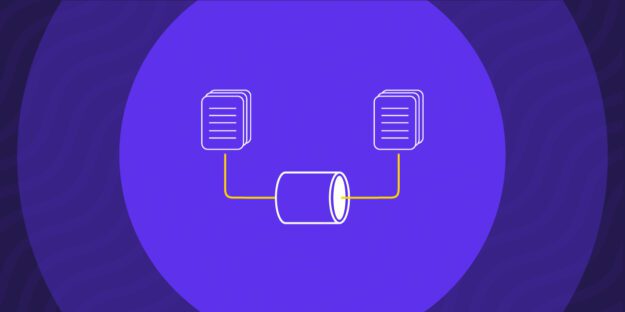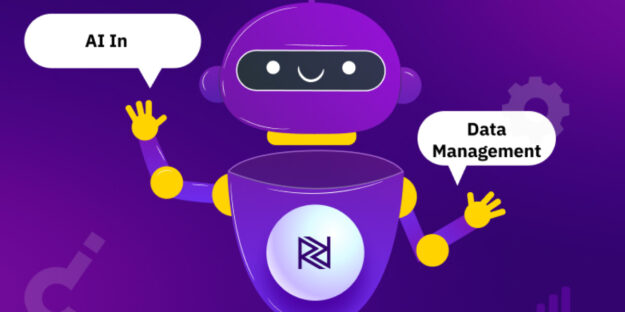What is ELT?
ELT is the method of extracting, loading, and transforming your critical data. This could include customer, sales and transaction, marketing, and operational data. You can utilize ELT for processing large volumes of information in modern data management systems, such as data warehouses, data lakes, and data integration platforms.
In contrast to traditional ETL (Extract, Transform, Load), where data is transformed before being loaded into a target system, ELT allows raw data to be loaded into a target system first. Afterward, it transforms the data according to the needs of your business.
The ELT method is useful when you must process data quickly, such as cloud data warehouses and data lakes. Technology, e-commerce, financial services, and biotech companies may benefit from ELT over ETL.
How Does ELT Work?
ELT works by extracting data from various sources: databases, APIs, or flat files. You’ll then load the raw data into a target system like a data warehouse or data lake. Once the data is in place, it transforms within the target system.
This sequence—extraction, loading, and then transformation—uses the processing power and scalability of modern data platforms. As a result, you can process and analyze data more efficiently.
3 Components of The ELT Process Explained
1. Extract
Extraction is the first stage of the ELT process.
During extraction, you gather data from various sources. Examples include on-premises databases, cloud storage, or third-party services. The methods of extraction can vary depending on the data source, including batch extraction, real-time data streams, and API calls.
The extracted data stays in its raw form and is ready for the next step: loading into the target system.
2. Load
In the loading stage, you’ll transfer the extracted raw data to the target systems—typically a data warehouse or data lake, such as Snowflake and Databricks. These systems can handle large volumes of unprocessed data efficiently.
The goal is to store the data securely and make it accessible for the next stage: transformation.
3. Transform
Transformation is the final stage of the process, where you convert the raw data within the target system. Transformations may include cleaning, filtering, aggregating, and formatting the data to meet your requirements.
This stage often uses the computational power of the target system. This allows for advanced data processing techniques, such as complex joins, data normalization, and data enrichment.
Common transformation techniques include data deduplication, type casting, and data anonymization.
What Is The Difference Between ELT & ETL?
ELT and ETL are both data integration processes. However, they differ mostly in the sequence of operations.
In ETL, data is extracted, transformed outside the target system, and then loaded into the final storage. In contrast, ELT loads the raw data directly into the target system, where it is then transformed.
All in all, this difference makes ELT more suitable for cloud environments, where data storage and processing power are common.
The 5 Business Benefits of ELT
1. Faster Time to Insights
With ELT, your organization can achieve faster data processing because raw data is loaded directly into the target system. This efficiency reduces the time to gain insights from data, which facilitates quicker decision-making.
2. Schema Flexibility
ELT provides greater schema flexibility by allowing businesses to load raw data without predefined schemas. This flexibility is beneficial in environments with diverse data sources and rapidly changing data structures.
3. Scalability
As data volumes grow, ELT scales efficiently by leveraging cloud data platforms. This means you can handle increasing data loads without significant changes to your ELT framework.
4. Integration with Modern Data Platforms
ELT processes are well-suited for integration with modern data platforms like cloud data warehouses and lakes. These platforms are optimized for the ELT approach, enabling seamless data processing and analytics.
5. Cost-Effectiveness
ELT can be more cost-effective compared to traditional ETL processes. Organizations can reduce infrastructure costs by offloading data transformation tasks to scalable cloud systems, minimizing the need for expensive on-premises hardware.
ELT Pipelines Explained
ELT pipelines are a series of automated processes managing the flow of data from its source to the final transformed state. These pipelines handle data extraction, loading, and transformation; they guarantee data is processed accurately and efficiently.
Here are some of the characteristics of ELT pipelines:
Data Extraction
ELT pipelines extract data from various origins, including databases, APIs, cloud storage, and file systems. These pipelines offer connectivity to multiple data sources, such as SQL and NoSQL databases—and can handle diverse data formats, such as JSON, XML, and CSV.
Data Loading
In the data loading phase, ELT pipelines load data into the target data warehouse or data lake before performing significant transformations. They support both batch processing, where large volumes of data are loaded at intervals, and real-time loading for continuous data streams.
Scalability is a crucial aspect: it ensures the pipeline can manage growing data volumes without performance degradation.
Data Transformation
Data transformation occurs in place by leveraging the processing capabilities of the target data warehouse. By utilizing SQL-based transformations, ELT pipelines can implement complex business logic—including data cleaning, aggregation, and normalization.
Version control is typically supported to track changes in transformation logic to guarantee consistency.
Automation and Scheduling
Automation and scheduling are integral to ELT pipelines; these processes run on predefined schedules or are event-triggered.
They feature error handling and recovery mechanisms, which can retry or roll back processes as needed. Ongoing monitoring of pipeline performance is standard, alongside alerting systems for failures or bottlenecks.
Data Quality Management
Data quality management is another key characteristic; it includes validation checks to ensure accuracy and completeness, tracking data lineage for transparency, and eliminating duplicates to maintain clean datasets.
Scalability and Flexibility
Scalability and flexibility are inherent in ELT pipelines, designed to scale horizontally or vertically to accommodate growing data needs. These pipelines are adaptable to changes in data sources, formats, or business requirements without requiring significant reconfiguration.
Security and Compliance
Security and compliance are also critical, with data encryption during extraction, transmission, and storage, strict access controls, and adherence to data governance policies and industry regulations such as GDPR and HIPAA.
Leveraging AI in the ELT Process
There are many reasons why you should use artificial intelligence for the ELT process. Here are the top reasons:
Intelligent Data Discovery
Intelligent data discovery is using AI to explore, analyze, and understand large data volumes from different sources. The process accelerates the conversion of raw data into actionable insights. As a result, this enhances the effectiveness of data-driven activities, such as ELT.
Intelligent Data Loading
Data loading can become smarter and more optimized when you leverage AI. For instance, AI-driven algorithms can prioritize and schedule data loads based on system performance, resource availability, and business priorities. This ensures the ELT operations are efficient.
Advanced/Automated Data Transformation
AI also plays a crucial role in advanced and automated data transformation. You can automate complex transformations, such as predictive data modeling and real-time anomaly detection, which further enhance the speed and accuracy of the ELT process.
The Benefits of AI in ELT
There are many benefits of using AI in ELT for your data processes. Here are some examples:
- Improved data accuracy: AI-driven ELT tools can reduce human error. This leads to more accurate data transformations and integrations.
- Faster processing times: AI can automate and optimize data extraction, transformation, and loading processes, significantly speeding up the overall workflow.
- Enhanced decision-making capabilities: AI provides insights from large datasets quickly.
- Adaptive to changing data patterns: AI systems can learn from new data, adapting to evolving patterns and ensuring that the ELT framework remains efficient over time.
- Scalability: AI-driven ELT solutions can easily scale to handle increasing volumes of data without compromising performance.
- Cost efficiency: Automation through AI reduces the need for extensive manual labor.
- Predictive analytics: AI can predict future trends based on historical data.
- Real-time data processing: AI tools can process and analyze data in real-time, which offers immediate insights and faster responses to changes.
The Challenges of Using AI in ELT
Many people are aware of the challenges AI poses to society, and using AI in ELT is no different. Here are some examples:
- Complexity of AI technologies: Implementing AI in ELT requires advanced knowledge in both data engineering and AI. This can be difficult for organizations to acquire and maintain.
- Steep learning curve: Organizations may face challenges in training their staff to effectively use AI-driven ELT tools, leading to potential delays in adoption.
- Bias in AI algorithms: AI systems may inherit biases from the data they are trained on, which can result in skewed or inaccurate outcomes. You may also experience AI hallucinations.
- High initial investment: The costs associated with developing or acquiring AI-driven ELT tools and the necessary infrastructure can be substantial.
- Data privacy and security concerns: Integrating AI into ELT processes can raise issues regarding data protection, especially when handling sensitive or personal information.
- Dependence on high-quality data: AI systems require large amounts of high-quality data to function effectively; poor data quality can lead to suboptimal performance.
- Maintenance and upkeep: Continuous updates and monitoring are required to ensure AI systems remain accurate and effective, adding to long-term maintenance costs.
Use Cases
ELT processes are widely used across various industries to optimize data management and analytics.
Common use cases include real-time data processing for customer analytics, large-scale data integration for financial reporting, and leveraging cloud ELT for IoT data management.
These applications highlight the versatility and effectiveness of ELT in business environments.
Now let’s jump into some case studies:
Case Studies
SENTA
SENTA is a brilliant example of a company using ELT to improve data operations. SENTA is a Shore Capital Partners portfolio company founded in 2019. Operating at maximum efficiency is required for SENTA. The more healthcare partner practices join, the more value SENTA can offer to its community.
Each time SENTA adds a new healthcare practice, a major part of its process is consolidating data into its centralized analytics system.
By using Rivery for their ELT processes, Senta achieved:
- 10x users using self-service analytics instead of going through data analysts. This benefit saved the company time and money.
- Major savings by cutting external consulting by using self-managed Rivery, Snowflake, and Sigma.
- Accelerated M&A data integration setup by 200%.
You can find out more about SENTA’s success here.
Armstrong
Armstrong—a non-asset-based logistics provider headquartered in Charlotte, NC—had major success with ELT for their data transformation. The company focuses on data utilization to differentiate itself from its industry competitors.
By using Rivery to help them with ELT processes, Armstrong achieved:
- A staggering 7500% reduction in the time taken to extract and consolidate data from a single source, slashing it from 10 hours to 8 minutes.
- Streamlined connectivity to any data source—including niche freight applications—within minutes rather than months.
- From exclusive access for the finance department to a minimum of 300 users across the company in Sigma by year-end.
Find out more about Armstrong’s success here.
Moving Forward
Unlock the full potential of your data with Rivery.
Rivery is a modern response for clients looking for an ELT cloud-based solution, with several components of the modern data platform combined in a single platform.
With over 200 no-code fully-managed connectors, advanced workflow orchestration, Data transformations via SQL and/or Python, reverse ELT (data activation), and data operations (full support for the development lifecycle/DataOps) Rivery works to best fit your data needs.
Unlike other ELT platforms, Rivery doesn’t charge by the number of databases or tables you’re loading into your data warehouse, nor does it charge by the number of rows or sync frequencies. Rivery offers on-demand pay-as-you-go pricing so you only pay for what you use.
Looking to join over 350 brands that use Rivery to create robust end-to-end data pipelines at scale, speed, and with full transparency? Get started with 1,000 free credits.
Minimize the firefighting. Maximize ROI on pipelines.





